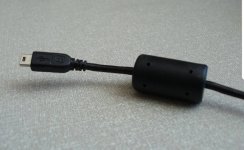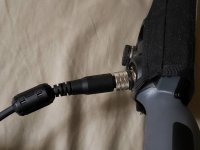laidback4sho
Hero Member
- Aug 31, 2014
- 623
- 898
- Detector(s) used
- Currently:
XP Deus v4.1
Minelab Equinox 800
Fisher Gold Bug 2
Previously:
Garrett GTA 500
Garrett Ultra GTA 1000
Garrett GTAx 1250
- Primary Interest:
- All Treasure Hunting
Hey guys,
I was on another forum a second ago, reading up on the Fisher Gold Bug 2, and I came across someone who was experiencing the effects of EMI on his machine.
Well, another fella chimed in and claimed that he had basically EMI-proofed his machine by attaching one of these little ferrite chokes to the cable, just before it enters the control unit. The photo below shows a ferrite choke. It's a little snap-on device that kills electromagnetic interference and can be purchased on Amazon very inexpensively.
Well this got me to thinking... if it would work on the Gold Bug 2, then there's no reason why it shouldn't work on the Equinox. So to test my theory, I'm about to buy a pack of these ferrite chokes from Amazon and test one out on my 800.
So far, the only fix I've seen for this machine's erratic behavior has been to put your cell phone in airplane mode. But what if it's not your cell phone? What if it's power lines or some other source that's causing your machine to act up? That's why I want to test this out for myself.
Anyone want to chime in with any questions or comments, please feel free. Maybe one of you have already done this with great success. Maybe one of you can tell me with certainty why this will or will not work.
Anyway, I'm out for now. I'll post my findings here once I've reached a conclusion as to whether this will work or not.
I was on another forum a second ago, reading up on the Fisher Gold Bug 2, and I came across someone who was experiencing the effects of EMI on his machine.
Well, another fella chimed in and claimed that he had basically EMI-proofed his machine by attaching one of these little ferrite chokes to the cable, just before it enters the control unit. The photo below shows a ferrite choke. It's a little snap-on device that kills electromagnetic interference and can be purchased on Amazon very inexpensively.
Well this got me to thinking... if it would work on the Gold Bug 2, then there's no reason why it shouldn't work on the Equinox. So to test my theory, I'm about to buy a pack of these ferrite chokes from Amazon and test one out on my 800.
So far, the only fix I've seen for this machine's erratic behavior has been to put your cell phone in airplane mode. But what if it's not your cell phone? What if it's power lines or some other source that's causing your machine to act up? That's why I want to test this out for myself.
Anyone want to chime in with any questions or comments, please feel free. Maybe one of you have already done this with great success. Maybe one of you can tell me with certainty why this will or will not work.
Anyway, I'm out for now. I'll post my findings here once I've reached a conclusion as to whether this will work or not.







